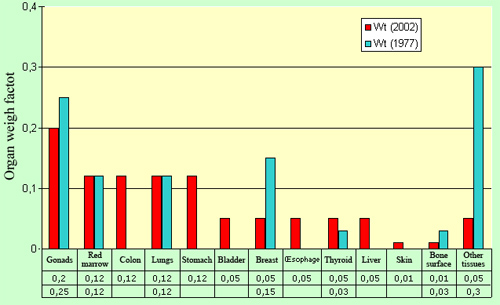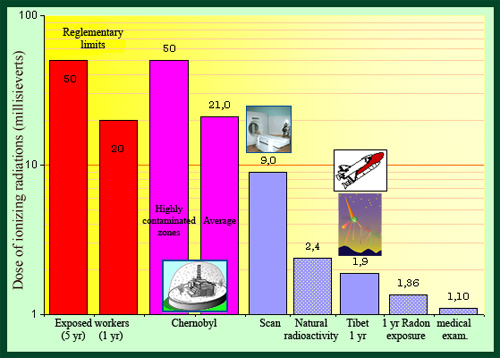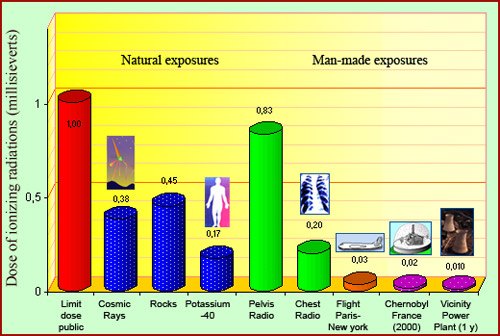A full-body dose, central in the field of radioprotection
The “effective dose” is a biological dose commonly used in radioprotection, as it determines how dangerous an individual’s exposure to radiations can be. It takes into consideration not only the nature of the incoming radiation but also the sensitivities of the body parts affected. The unit of ‘effective dose’ is the sievert, the same unit used for the equivalent dose absorbed locally by an organ, a gland or any other part of the body.
In the field of radioprotection it is this effective dose which interests us, though the equivalent dose is what matters in medicine. The decision by radioprotectionists to use the same unit for both doses does not help the non expert to clarify these matters.

Organ or tissue weight factors
The effective dose is calculated by multiplying the equivalent dose absorbed by each organ with a specific weight factor and then adding the total. The sum of all the different factors must be equal to 1. As time goes on, the data about bodies sensitivity become more accurate, the values of these weight factors have improve. The values put in place in 1977 (in blue), for instance, are less accurate than those updated in 2002 (in red). For this reason effective dose values calculated years ago may differ with more recent ones.
© IN2P3
The purpose of the effective dose is to provide a dose relevant for the entire body. This involves taking into account how each part of the body has been exposed, and how each is sensitive to radiations : a gray absorbed in the thyroid would contribute much more than in a muscle). Therefore the ‘equivalent dose’ absorbed by each organ is multiplied by a sensitivity factor – a weight – reflecting its importance. Then the effective dose is calculated by adding up all the weighted equivalent doses.

Average and low doses
Examples of exposures considered medium and low. Two of these (in red) are annual regulatory limits adopted in the USA and in Europe for exposed workers. The doses of exposure to natural radioactivity, to radon, and to medical examinations are annual averages observed in France.
© IN2P3
The sensitivity or weight factors add up to 1. These factors are normalized in such a way as to ensure that when a person received a uniform gamma exposure, the effective dose (in sieverts) is equivalent to the absorbed dose (in grays). The equivalent doses that are used to calculate the effective doses represent amount of energy deposited per unit of volume in an organ or tissue, and are independent of the size this organ or tissue. If the weighting factors are correctly determined, then valid comparisons can be made between the doses absorbed by people of differing sizes or ages, such as a baby and an adult.
Effective doses allow also to compare global exposures of different natures or origins. For example, it allows comparisons with the doses due to natural radioactivity, often considered as a standard.
The range of doses varies from a few sieverts to fraction of a millisievert (mSv). The effective doses of the order of a sievert are considered strong. They lead to serious “deterministic” effects that can be deadly. For lower doses, the effects may appear or not appear. It is the probability of their occurrence that depends on the dose, not their severity. Such effects are called probabilistic.

Domain of very low doses
Exposure to doses under 1 mSv can be considered as very low. The 1 mSv limit (shown in red on the far left) is the legal maximum for artificial sources of radiation besides medicine : medical exposures are excluded since this limit is exceeded when with a scanner or approached for a radiograph of the pelvis. Examples given of exposure to natural radioactivity or resulting from human activities are annual averages (radiographies , air flights …). For doses resulting from human activities, the share of the non-medical, in particular of nuclear power plants is low.
© IN2P3
The levels to which we are exposed due to natural radioactivity, medical diagnostics and human activities are very low in comparison. They are in the range of millisieverts (mSv, thousandth of a sievert). For example, the annual dose due to natural radioactivity is 2.4 mSv in France.
The effective dose is in some ways an average of the local equivalent doses absorbed by an individual. For example, in radiodiagnostics, such as in a mammography, only a small part of the body is irradiated. The effective dose received during a mammography varies between 0.1 and 0.01 millisieverts (mSv), but this number is not the most relevant as it applies to the whole body. More important is the equivalent dose absorbed by the breast : it should not be greater than a certain limit – say 1 mSv. In radio and nuclear therapies, it is also the equivalent doses that count more.
This animation by UK not-for-profit Nuffield Health shows just how little radiation medical scans expose us to by comparing the levels to natural background radiation, air travel and even space travel. Produced with the help of the Radiological Protection Centre in London.
Link to Nuffield Health web site
NEXT : Doses scale, Millisievert
Other articles on the subject « Radioactive Doses »
Radioactive Activity Doses
Becquerel or Bq : the activity unit of a radioactive source The activity of a sample of matter wh[...]
Absorbed doses
Gray or Gy : unit of energy deposited in matter by radiation The ‘absorbed dose’ is defined as th[...]
Biological doses
Sievert (Sv) : the unit of doses for the living The energy deposited in a living organism by radi[...]
Equivalent Dose
A local biological dose The concept of the “equivalent dose” which takes into account[...]
MilliSievert
A unit for low doses of radioactivity After a nuclear accident or accident of radioactivity, it i[...]
Dose Scale
A dose classification for acute exposures When dealing with exposure to radiations, what do we me[...]